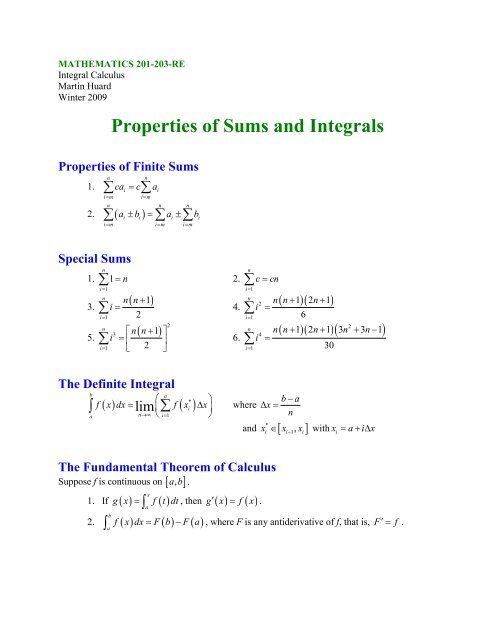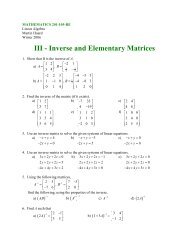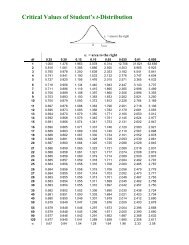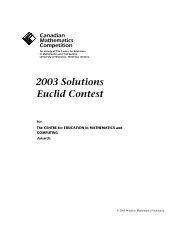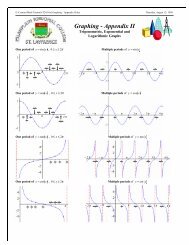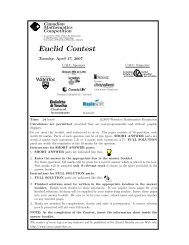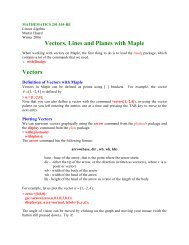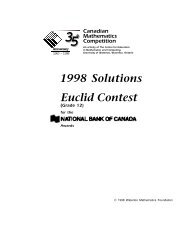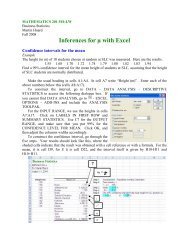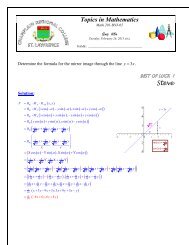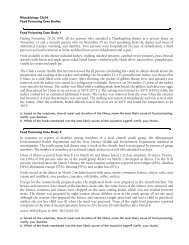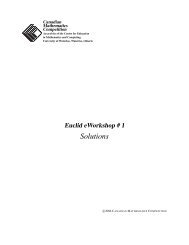Properties of Sums and Integrals - SLC Home Page
Properties of Sums and Integrals - SLC Home Page
Properties of Sums and Integrals - SLC Home Page
- No tags were found...
Create successful ePaper yourself
Turn your PDF publications into a flip-book with our unique Google optimized e-Paper software.
MATHEMATICS 201-203-RE<br />
Integral Calculus<br />
Martin Huard<br />
Winter 2009<br />
<strong>Properties</strong> <strong>of</strong> <strong>Sums</strong> <strong>and</strong> <strong>Integrals</strong><br />
<strong>Properties</strong> <strong>of</strong> Finite <strong>Sums</strong><br />
1.<br />
n<br />
∑<br />
n<br />
∑<br />
ca = c a<br />
i<br />
i= m<br />
i=<br />
m<br />
n n n<br />
∑ ∑ ∑<br />
2. ( )<br />
i i i i<br />
i= m i= m i=<br />
m<br />
i<br />
a ± b = a ± b<br />
Special <strong>Sums</strong><br />
1.<br />
3.<br />
5.<br />
n<br />
∑ 1 = n<br />
2.<br />
i=<br />
1<br />
i=<br />
1<br />
( + 1)<br />
n<br />
n n<br />
∑ i =<br />
4.<br />
2<br />
( + 1) ⎤<br />
2<br />
⎡ n n<br />
∑ n<br />
3<br />
i = ⎢ ⎥<br />
i=<br />
1 2<br />
6.<br />
⎣<br />
⎦<br />
n<br />
∑<br />
i=<br />
1<br />
n<br />
∑<br />
i=<br />
1<br />
n<br />
∑<br />
i=<br />
1<br />
c = cn<br />
i<br />
i<br />
2<br />
4<br />
n n<br />
=<br />
( + 1)( 2n<br />
+ 1)<br />
6<br />
( + 1)( 2 + 1)( 3 2 + 3 −1)<br />
n n n n n<br />
=<br />
30<br />
The Definite Integral<br />
b<br />
n<br />
⎛<br />
* ⎞<br />
∫ f ( x) dx = lim⎜∑<br />
f ( xi<br />
) ∆x<br />
⎟ where<br />
n→∞ ⎝ i=<br />
1 ⎠<br />
a<br />
b − a<br />
∆ x =<br />
n<br />
*<br />
<strong>and</strong> x [ x x ]<br />
∈<br />
−1,<br />
with x i<br />
= a + i∆<br />
x<br />
i i i<br />
The Fundamental Theorem <strong>of</strong> Calculus<br />
Suppose f is continuous on [ a,<br />
b ] .<br />
x<br />
1. If g ( x) = ∫ f ( t)<br />
dt , then g ( x) f ( x)<br />
a<br />
b<br />
2. ( ) = ( ) − ( )<br />
′ = .<br />
∫ f x dx F b F a , where F is any antiderivative <strong>of</strong> f, that is, F′ = f .<br />
a
<strong>Properties</strong> <strong>of</strong> the integral<br />
∫ ∫<br />
1. ( ) = ( )<br />
cf x dx c f x dx<br />
∫ ∫ ∫<br />
2. ⎡ ( ) ± ( ) ⎤ = ( ) ± ( )<br />
⎣ f x g x ⎦ dx f x dx g x dx<br />
b<br />
a<br />
3. ( ) = − ( )<br />
∫a<br />
∫ b<br />
f x dx f x dx<br />
c b b<br />
4. ( ) + ( ) = ( )<br />
∫ ∫ ∫<br />
f x dx f x dx f x dx<br />
a c a<br />
b<br />
5. If f ( x) ≥ 0 for a ≤ x ≤ b , then ( ) 0<br />
∫ f x dx ≥ .<br />
a<br />
b<br />
b<br />
6. If f ( x) ≥ g ( x)<br />
for a ≤ x ≤ b , then ( ) ≥ ( )<br />
∫ f x dx g x dx<br />
a ∫ .<br />
a<br />
b<br />
7. If m ≤ f ( x)<br />
≤ M for a ≤ x ≤ b , then m( b − a) ≤ f ( x) dx ≤ M ( b − a)<br />
8. udv = uv − vdu<br />
∫ .<br />
a<br />
b<br />
b b<br />
∫ ∫ ∫ udv = uv ] − vdu<br />
a<br />
a ∫ (Integration by parts)<br />
a<br />
Table <strong>of</strong> Indefinite <strong>Integrals</strong><br />
1.<br />
n+<br />
1<br />
n x<br />
∫ x dx = + C n ≠ − 1<br />
2.<br />
n + 1<br />
∫<br />
1<br />
dx = ln x + C<br />
x<br />
3.<br />
e x<br />
dx e x<br />
∫ = + C<br />
4.<br />
∫<br />
x<br />
x a<br />
a dx = + C<br />
ln a<br />
5. ∫ sin xdx = − cos x + C<br />
6. ∫ cos xdx = sin x + C<br />
7.<br />
sec 2<br />
∫ xdx = tan x + C<br />
8.<br />
∫<br />
csc<br />
2<br />
xdx = − cot x + C<br />
9. ∫ sec x tan xdx = sec x + C<br />
10. ∫ csc x cot xdx = − csc x + C<br />
11. ∫ sec xdx = ln sec x + tan x + C 12. ∫ csc xdx = ln csc x − cot x + C<br />
13. ∫ tan xdx = ln sec x + C<br />
14. ∫ cot xdx = ln sin x + C<br />
1<br />
15. ∫ dx = arctan x + C<br />
16.<br />
2<br />
1+<br />
x<br />
∫<br />
1<br />
1−<br />
x<br />
2<br />
dx = arcsin x + C


